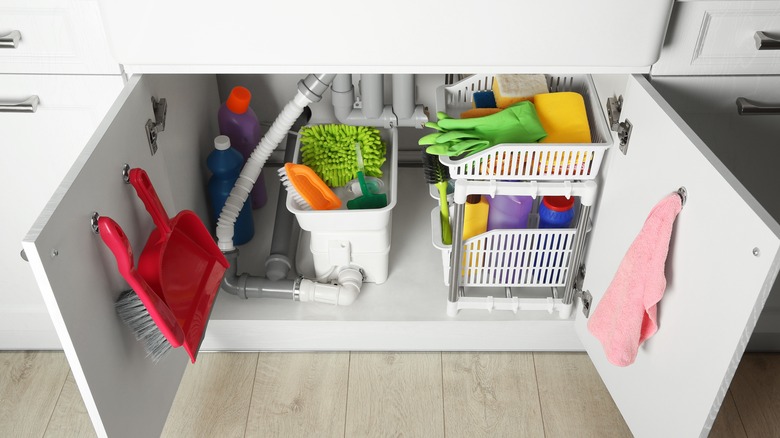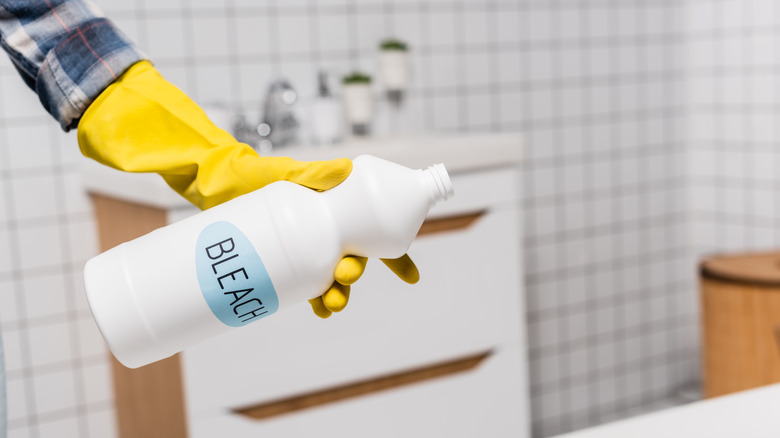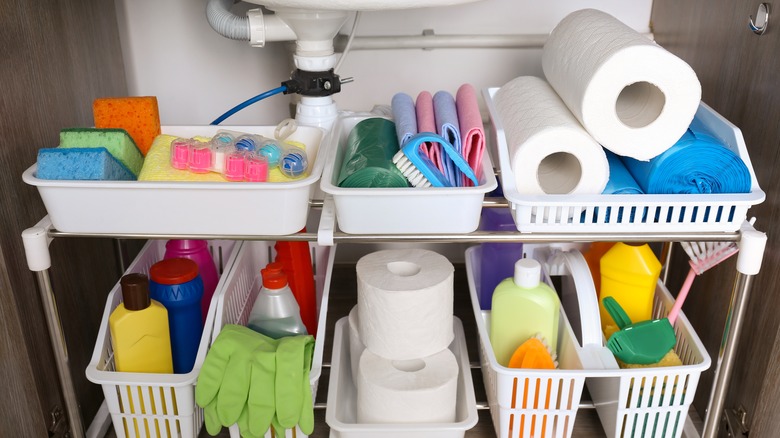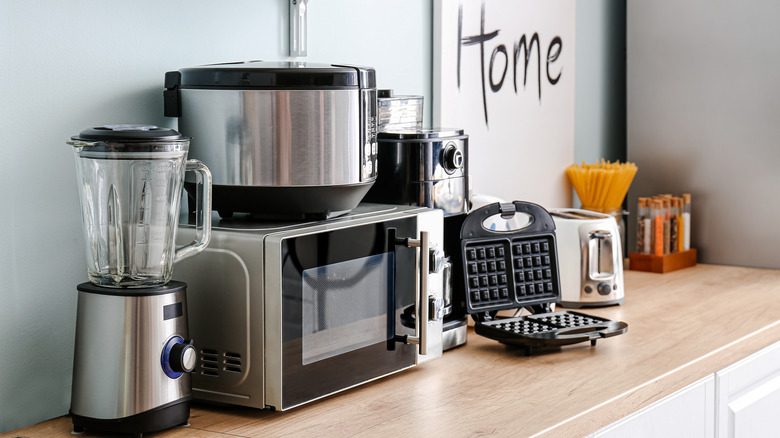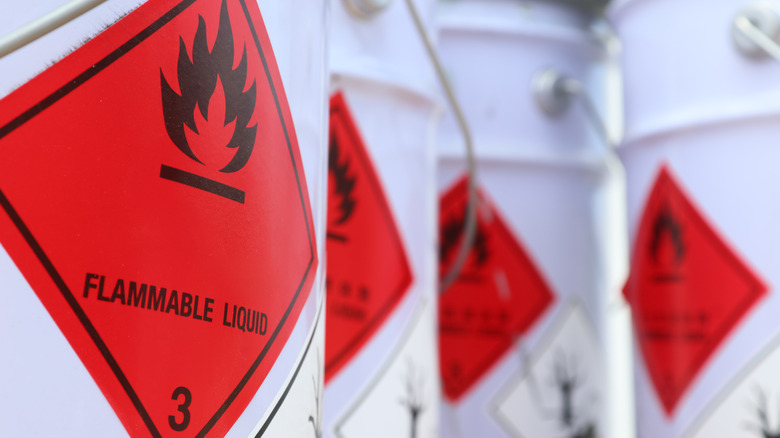4 Things You Should Purge From Under Your Kitchen Sink
Most people can likely attest that they haven't taken an inventory of what's under their kitchen sink in quite a while, and that's because it's probably where you're guilty of storing all that extra items that you're not really sure where else to put -– and we don't blame you, especially since storage space is so valuable and often difficult to come by. In fact, HSH surveyed over 1,000 Americans to learn their biggest issues with their current homes, and 67% of responders reported that lack of storage was in their top five.
With so many households lacking valuable and much-needed storage space, it's only natural to want to make your own -– and under the kitchen or the bathroom sink seems like the perfect place to house various household products in a way that keeps them easily on hand while also keeping them hidden from plain sight. And while utilizing the area beneath your sink to store miscellaneous household items can be convenient, it is also important to be aware that storing things beneath the sink can actually pose serious environmental and health hazards to you and your family if you are not careful.
1. Harsh chemicals
Organizing coach Lisa Dooley says via Real Simple that one of the most dangerous things you could store under your sink is anything containing harsh or toxic chemicals, commonly found in household cleaners such as bleach. Though care should always be exercised when using and storing any sort of chemicals, storing them under the sink is a particularly bad idea.
Not only are toxic chemicals under the sink easily accessible for curious young children, but when inadvertently spilled and mixed with other cleaners or chemicals, the chemical reaction could be deadly if inhaled. According to Good Housekeeping, various common household cleaners –- the kind that are currently under many people's sinks -– can create a potentially toxic chemical reaction when mixed that could cause skin irritation, trouble breathing, or even death. Because of the potential for danger, multiple types of household cleaners containing harsh and toxic chemicals should not be stored together under a sink where they could easily spill and mix.
Dooley suggests storing any harsh chemicals safely out of reach in the garage or the basement, where they will be out of reach from children and pets and where they don't run the risk of getting knocked over.
2. Paper products
While keeping extra paper bags, paper towels, and toilet paper under the kitchen sink might seem like it makes the most sense when it comes to convenience, Suzanne Pollak, co-founder of the Charleston Academy of Domestic Pursuits, shares via Real Simple that all of your paper products are best kept elsewhere.
Leaky pipes can easily damage and ruin your paper goods, and constantly restocking your paper towel, toilet paper, and tissue supply is hard on your wallet –- and just creates a soggy paper mess you will have to throw away. Even if you can guarantee your sink pipes don't leak, wet paper products beneath your sink are also a perfect recipe for mold and bacteria growth, especially since the area is already damp and doesn't get much airflow.
Instead of risking any of your paper products getting wet and damaged, Pollack recommends storing them in a closet or pantry instead, where they can still be easily accessed but won't get wet.
3. Small appliances
Kitchen storage can be particularly difficult to come by, so unoccupied space under the kitchen sink might seem like prime real estate for storing small appliances such as your blender, toaster, waffle maker, or other appliance. However, as convenient as this space might be to keep your small kitchen appliances, it's safer to store them elsewhere.
State Farm explains that leaky pipes under the sink can easily lead to water damage -– and most of your kitchen appliances aren't cheap. Not to mention, if you store your kitchen appliances under the sink where you also stored your household cleaners in the past (which you now know to no longer do), then there's a chance those appliances are no longer considered to be food-safe due to potential exposure to any hazardous or toxic chemicals that may have accidentally spilled or leaked.
This also goes for personal appliances under your bathroom sink, such as hair dryers, curling irons, and flat irons. Though the tools you use to do your hair don't have to come into contact with food, moisture trapped beneath your bathroom sink can still lead to water damage and rust — and just like your kitchen appliances, your personal appliances aren't cheap either. Instead, State Farm suggests storing your small appliances somewhere they won't run the risk of getting wet, such as the pantry, closet, or kitchen island without a sink.
4. Flammable products
Anything flammable should also never be stored under your sink, and homeowners should be advised that a lot more products in their house might be more flammable than they would think. Certain solvents, paint thinners, stains, cleaners, and polishes are actually highly flammable and don't necessarily need to come into contact with an open flame to be dangerous. In fact, Bob Benedetti, Principal Flammable Liquids Engineer at the National Fire Protection Association, shares via Consumer Reports that a lot of these liquid products actually heat up as they dry. This means that the old rag you used to apply your paint stain is particularly susceptible to catching fire –- especially if it is mishandled or improperly stored under the sink, which can accelerate the heating process. Professional organizer Ginny Underwood adds via Real Simple that any polishes, solvents, or cleaners containing linseed or flaxseed oil are especially flammable and susceptible to spontaneous combustion.
Because rags that have been soaked in these flammable liquids risk catching fire regardless of where they are stored, it is best to safely dispose of them when you finish your DIY project. Consumer Reports recommends leaving the rags outside to dry entirely before disposal, which could take two days or more depending on how much liquid was used.
